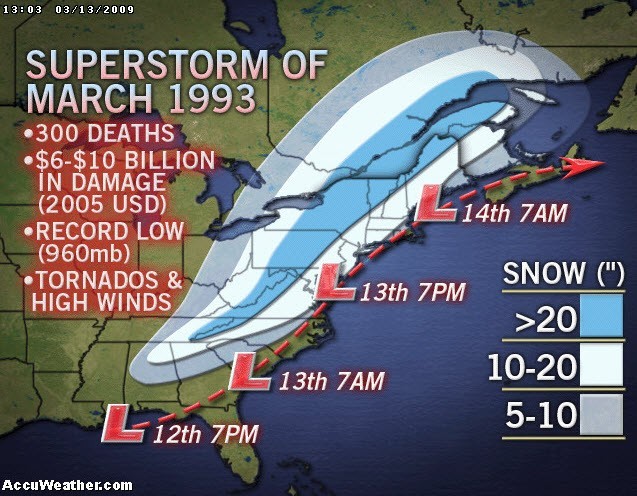The storm slammed into Gainesville on March 13, 1993, a Saturday.
The week's weather had started innocently enough in north Georgia, with springlike conditions although a bit warmer than usual. But by the time the week ended, much of of the Eastern Seaboard, however, was buried in snow - several feet of the white stuff in many places from
Georgia to Maine.
Some places in Florida even got some snow. But for the Sunshine State, tornadoes, spawned by the storm system, were the big problem. In addition to tornadoes and heavy snow, there were hurricane force winds in some places as the system moved up the east coast... the blizzard conditions unlike anything most people in Georgia and other parts of the Southeast had witnessed before or since.
The snow began falling about daybreak that Saturday morning, nothing out of the ordinary as north Georgia snows go. But before long the winds got stronger and the snow got heavier and at times appeared to be "blowing sideways."
Motorists and pedestrians caught in the storm soon found themselves dealing with a "whiteout," - a rare weather condition in the South but not that uncommon in places such as the Dakotas, Nebraska and Iowa. It is caused by either snow or sand and reduces visibility of the point where the horizon literally disappears.
Conditions were so bad in Gainesville by about 9:30 that many motorists were stopping because not only were they having trouble seeing but the windshield wipers on their cars and trucks could not keep the windshields clear, the snow as so intense.
Even some experts, such as Georgia's then-state climatologist David Stooksbury, were caught off guard by the severity of the storm.
Stooksbury in an interview with AccessNorthGa.com ten years ago on the storm's 10th anniversary described it as unlike anything he's ever seen.
"I remember being woken up by the weather radio and hearing the announcer saying we were under a blizzard warning and thinking 'Did I hear that correctly?'" Stooksbury said.
Stooksbury also remembers how impressed he was with the accuracy of the forecasts which had warned of a coming snowstorm several days earlier.
"I'm not sure we responded the way we should have probably because we just didn't realize what was coming. But the forecast at the time was very accurate," Stooksbury said.
Stooksbury notes that the storm, which killed more than 250 people from the Gulf Coast to Maine, resulted in record low barometric readings (the kinds usually associated with a hurricane), record snowfalls, and record wind gusts.
He says the blizzard was caused by a low pressure system out of the Gulf of Mexico carrying with it lots of warm air that collided with very cold air from the north - something that usually produces thunderstorms and tornadoes this time of the year in Georgia. However, on March 13, 1993, the conditions were right for a blizzard instead of springlike storms.
The storm paralyzed Gainesville and other parts of Georgia for a couple of days, while rugged mountain regions were cut off from civilization for weeks. Scores of trees, blown down or uprooted by the strong winds, blocked roads to many isolated mountain homes and cabins. Some people froze to death or died from carbon monoxide poisoning after they tried to use charcoal grills or stoves for heating and cooking. Power was out for days in some places, a week or more in others.
A crew from WSB-TV in Atlanta was stranded for several days at Fort Mountain State Park near Chatsworth in northwest Georgia. The reporter and other members of the crew had gone there on Friday to do a story on preparations for the storm but after it struck so suddenly and with such intensity, it was impossible to leave until the roads could be cleared of snow and ice and trees.
The day after the storm, though the snow had ended and the winds subsided, the streets of Gainesville were virtually deserted. Convenience stores that were open had few customers. The same was true of other places that had managed to stay open overnight or re-open Sunday morning.
There had been a youth swim meet in Gainesville on Saturday and some out-of-towners found themselves spending an unexpected or extra night in Gainesville because they couldn't get back home after it was over. By Sunday morning, homeless shelters in town were overflowing with the homeless and others who had sought a warm place to spend the night.
The storm killed 270 people from Florida to Maine, caused $3 billion in damages (in 1993 dollars) and affected half the population of the country.
Hundreds if not thousands of motorists were stranded on snow-packed Interstate 75 through northwest Georgia. National Guardsmen in four-wheel drive vehicles made their way up the interstate, handing out bags of fruit to motorists.
It was just a week before the official start of spring, with azaleas and dogwoods already budding in many places.
Airports were closed and governors declared emergencies as 1.5 million southerners were without power and thousands of travelers were stranded at airports and iced-over highways.
Fifteen people were killed in Georgia, while the death toll across the U.S., Canada and in Cuba hit 310... 270 in the U.S. The storm caused $3 billion in damages (1993 dollars) in the U.S. and affected half the country's population.
(Click on the links below for more information.)
(Sources: Jacobs Media Corp. news archives, AccuWeather.com, the Associated Press, the author who covered and directed coverage of the storm for Jacobs Media, and the National Weather Service.)

Courtesy AccuWeather.com
http://accesswdun.com/article/2013/3/259252
